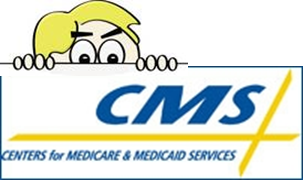 Fingerprint-based Background Check for CMS Enrollment Effective August 6, 2014.
Fingerprint-based Background Check for CMS Enrollment Effective August 6, 2014.
The implementation of fingerprint-based background checks as part of enhanced enrollment screening provisions contained in Section 640 of the Affordable Care Act has begun.
Fingerprint-based background checks will now be required for all individuals with a 5 percent or greater ownership interest in a provider or supplier that falls into the high risk category and is currently enrolled in Medicare or has submitted an initial enrollment application. The fingerprint-based background check requirement will be conducted in phases. In the first phase, providers or suppliers will receive notification of the fingerprint requirements from their MAC and will have 30 days from the date of the letter to be fingerprinted.
If an initial enrollment application is received by the MAC and the provider or supplier is required to obtain a fingerprint-based background check, the MAC will not begin processing the application until the fingerprint-based background check has been completed and the results are received. The effective date of enrollment will be determined by the date the fingerprint results are received.
Chapter 15, Section 19.2.1 of the “Program Integrity Manual” (PIM) provides the list of the three screening categories, the provider types assigned to each category, a description of the applicable screening processes and the procedures to be used for each category.
CMS awarded the Fingerprint-based Background Check contract to Accurate Biometrics located in Chicago, Illinois on July 8, 2014. Individuals with questions should contact Accurate Biometrics prior to being fingerprinted to ensure the fingerprint results are accurately submitted to the Federal Bureau of Investigation (FBI) and properly returned to CMS.
Accurate Biometrics may be contacted by phone (866-361-9944) or by accessing their website
at www.cmsfingerprinting.com.
Potential High Risk Applicants(DMEPOS, HHA and those with adjusted assignment by CMS to High Risk due to previous problems) can now expect the following agency screening actions;
(1) Verifies that a provider or supplier meets all applicable Federal regulations and State requirements for the provider or supplier type prior to making an enrollment determination.
(2) Conducts license verifications, including licensure verifications across State lines for physicians or nonphysician practitioners and providers and suppliers that obtain or maintain Medicare billing privileges as a result of State licensure, including State licensure in States other than where the provider or supplier is enrolling.
(3) Conducts database checks on a pre- and post-enrollment basis to ensure that providers and suppliers continue to meet the enrollment criteria for their provider/supplier type.
(4) Conducts an on-site visit.
(5) Conducts a fingerprint-based criminal history record check of the Federal Bureau of Investigation’s Integrated Automated Fingerprint Identification System on all individuals who maintain a 5 percent or greater direct or indirect ownership interest in the provider or supplier.
Application Fees = Don’t forget to submit your “fees”.
All providers and suppliers must submit the current application fees when they are;
- initially enrolling in Medicare,
- adding a practice location, or
- revalidating their enrollment information,
Physicians, non-physician practitioners, physician group practices and non-physician group practices are exempt from the application fees UNLESS they are enrolling as a DMEPOS supplier via the CMS-855S.
The fee for January 1, 2014, through December 31, 2014 is $542.00.
42CFR424.518 As of 8/20/2014
Title 42: Public Health
PART 424—CONDITIONS FOR MEDICARE PAYMENT
Subpart P—Requirements for Establishing and Maintaining Medicare Billing Privileges
§424.518 Screening levels for Medicare providers and suppliers.
A Medicare contractor is required to screen all initial applications, including applications for a new practice location, and any applications received in response to a revalidation request based on a CMS assessment of risk and assignment to a level of “limited,” “moderate,” or “high.”
(a) Limited categorical risk—
(1) Limited categorical risk: Provider and supplier categories. CMS has designated the following providers and suppliers as “limited” categorical risk:
(i) Physician or nonphysician practitioners (including nurse practitioners, CRNAs, occupational therapists, speech/language pathologists, and audiologists) and medical groups or clinics.
(ii) Ambulatory surgical centers.
(iii) Competitive Acquisition Program/Part B Vendors.
(iv) End-stage renal disease facilities.
(v) Federally qualified health centers.
(vi) Histocompatibility laboratories.
(vii) Hospitals, including critical access hospitals, Department of Veterans Affairs hospitals, and other federally owned hospital facilities.
(viii) Health programs operated by an Indian Health Program (as defined in section 4(12) of the Indian Health Care Improvement Act) or an urban Indian organization (as defined in section 4(29) of the Indian Health Care Improvement Act) that receives funding from the Indian Health Service pursuant to Title V of the Indian Health Care Improvement Act.
(ix) Mammography screening centers.
(x) Mass immunization roster billers
(xi) Organ procurement organizations.
(xii) Pharmacies newly enrolling or revalidating via the CMS-855B application.
(xiii) Radiation therapy centers.
(xiv) Religious non-medical health care institutions.
(xv) Rural health clinics.
(xvi) Skilled nursing facilities.
(2) Limited screening level: Screening requirements. When CMS designates a provider or supplier as a “limited” categorical level of risk, the Medicare contractor does all of the following:
(i) Verifies that a provider or supplier meets all applicable Federal regulations and State requirements for the provider or supplier type prior to making an enrollment determination.
(ii) Conducts license verifications, including licensure verifications across State lines for physicians or nonphysician practitioners and providers and suppliers that obtain or maintain Medicare billing privileges as a result of State licensure, including State licensure in States other than where the provider or supplier is enrolling.
(iii) Conducts database checks on a pre- and post-enrollment basis to ensure that providers and suppliers continue to meet the enrollment criteria for their provider/supplier type.
(b) Moderate categorical risk—
(1) Moderate categorical risk: Provider and supplier categories. CMS has designated the following providers and suppliers as “moderate” categorical risk:
(i) Ambulance service suppliers.
(ii) Community mental health centers.
(iii) Comprehensive outpatient rehabilitation facilities.
(iv) Hospice organizations.
(v) Independent clinical laboratories.
(vi) Independent diagnostic testing facilities.
(vii) Physical therapists enrolling as individuals or as group practices.
(viii) Portable x-ray suppliers.
(ix) Revalidating home health agencies.
(x) Revalidating DMEPOS suppliers.
(2) Moderate screening level: Screening requirements. When CMS designates a provider or supplier as a “moderate” categorical level of risk, the Medicare contractor does all of the following:
(i) Performs the “limited” screening requirements described in paragraph (a)(2) of this section.
(ii) Conducts an on-site visit.
(c) High categorical risk—
(1) High categorical risk: Provider and supplier categories. CMS has designated the following home health agencies and suppliers of DMEPOS as “high” categorical risk:
(i) Prospective (newly enrolling) home health agencies.
(ii) Prospective (newly enrolling) DMEPOS suppliers.
(2) High screening level: Screening requirements. When CMS designates a provider or supplier as a “high” categorical level of risk, the Medicare contractor does all of the following:
(i) Performs the “limited” and “moderate” screening requirements described in paragraphs (a)(2) and (b)(2) of this section.
(ii)(A) Requires the submission of a set of fingerprints for a national background check from all individuals who maintain a 5 percent or greater direct or indirect ownership interest in the provider or supplier; and
(B) Conducts a fingerprint-based criminal history record check of the Federal Bureau of Investigation’s Integrated Automated Fingerprint Identification System on all individuals who maintain a 5 percent or greater direct or indirect ownership interest in the provider or supplier.
(3) Adjustment in the categorical risk. CMS adjusts the screening level from “limited” or “moderate” to “high” if any of the following occur:
(i) CMS imposes a payment suspension on a provider or supplier at any time in the last 10 years.
(ii) The provider or supplier—
(A) Has been excluded from Medicare by the OIG; or
(B) Had billing privileges revoked by a Medicare contractor within the previous 10 years and is attempting to establish additional Medicare billing privileges by—
(1) Enrolling as a new provider or supplier; or
(2) Billing privileges for a new practice location;
(C) Has been terminated or is otherwise precluded from billing Medicaid;
(D) Has been excluded from any Federal health care program; or
(E) Has been subject to any final adverse action, as defined at §424.502, within the previous 10 years.
(iii) CMS lifts a temporary moratorium for a particular provider or supplier type and a provider or supplier that was prevented from enrolling based on the moratorium, applies for enrollment as a Medicare provider or supplier at any time within 6 months from the date the moratorium was lifted.
(d) Fingerprinting requirements.
An individual subject to the fingerprint-based criminal history record check requirement specified in paragraph (c)(2)(ii)(B) of this section—
(1) Must submit a set of fingerprints for a national background check.
(i) Upon submission of a Medicare enrollment application; or
(ii) Within 30 days of a Medicare contractor request.
(2) In the event the individual(s) required to submit fingerprints under paragraph (c)(2) of this section fail to submit such fingerprints in accordance with paragraph (d)(1) of this section, the provider or supplier will have its billing privileges—
(i) Denied under §424.530(a)(1); or
(ii) Revoked under §424.535(a)(1).
 20 Years after HIPPA established a national Fraud and Abuse Control Program, the enforcement agencies are still providing impressive results.
20 Years after HIPPA established a national Fraud and Abuse Control Program, the enforcement agencies are still providing impressive results. For CY 2017, the CPT Editorial Panel will deleted four CPT codes (97001, 97002, 97003, and 97004) and create eight new CPT codes (97X61-97X68) to describe the evaluation procedures furnished by physical therapists and occupational therapists. There are three new codes, stratified by complexity, to replace a single code, 97001, for physical therapy (PT) evaluation, three new codes, also stratified by complexity, to replace a single code, 97003, for occupational therapy (OT) evaluation, and one new code each to replace the reevaluation codes for physical and occupational therapy – 97002 and 97004.
For CY 2017, the CPT Editorial Panel will deleted four CPT codes (97001, 97002, 97003, and 97004) and create eight new CPT codes (97X61-97X68) to describe the evaluation procedures furnished by physical therapists and occupational therapists. There are three new codes, stratified by complexity, to replace a single code, 97001, for physical therapy (PT) evaluation, three new codes, also stratified by complexity, to replace a single code, 97003, for occupational therapy (OT) evaluation, and one new code each to replace the reevaluation codes for physical and occupational therapy – 97002 and 97004.






 What’s Up With Guidance?
What’s Up With Guidance?